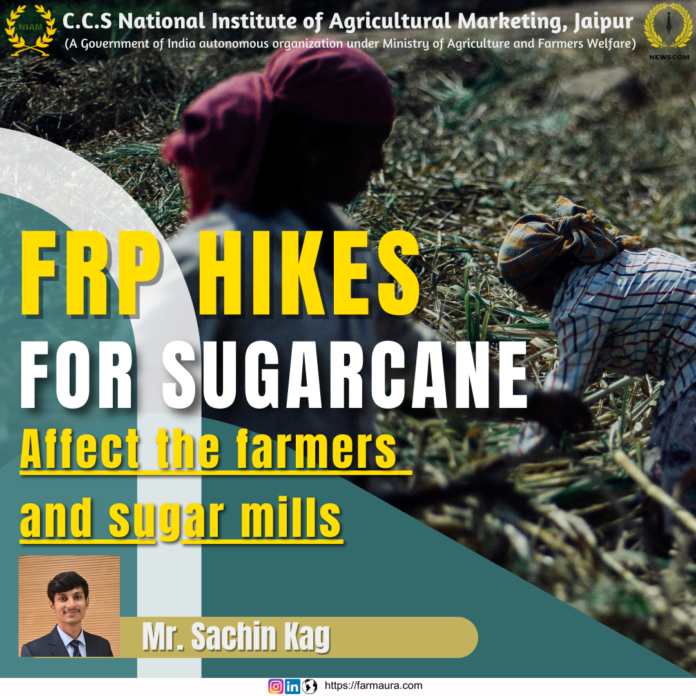Despite the government increasing sugarcane prices, the sugar industry continues to face unresolved issues. Amidst protests from farmers on the borders of Delhi, the Cabinet Committee on Economic Affairs approved a fair and remunerative price (FRP) of ₹340 per quintal for the 2024-25 sugar season, based on a 10.25% sugar recovery rate. The government emphasized its commitment to doubling farmers’ income, stating that the new FRP represented an 8% increase over the current season. However, the underlying problems affecting the sugar industry remain unaddressed despite the FRP hike.
What is Fair and Remunerative Price (FRP)?
Fair and Remunerative Price (FRP) is the lowest payment sugar factories are legally required to give farmers for their sugarcane. To determine FRP, factors such as the cost of producing sugarcane, the amount of sugar extracted, the selling price of sugar, and the profits made from byproducts (like molasses and bagasse) are taken into account. Farmers’ profit margins and alternative crop revenue are also considered. The FRP is set by the national government based on recommendations from the Commission for Agricultural Costs and Prices (CACP), and after discussions with state governments and the sugar industry.
How does is affect Minimum Selling Price (MSP)?
The Minimum Selling Price (MSP) for sugar, unlike the Minimum Support Price (MSP) for other crops, was set by the government in the Sugar Price (Control) Order. While the MSP for crops is the minimum government-set price to purchase crops from farmers, the MSP for sugar refers to the minimum price sugar mills can sell sugar to the market. The government established this MSP to ensure sugar mills recover at least their production costs, facilitating payments for sugarcane to farmers. The MSP for sugar is calculated by combining the Fair and Remunerative Price (FRP) for sugarcane with the minimum conversion costs incurred by efficient sugar mills. Despite multiple increases in the Fair and Remunerative Price (FRP) of sugarcane from ₹255 per quintal in 2017-18 to ₹340 per quintal, the Minimum Support Price (MSP) of sugar has remained unchanged at ₹3100 per quintal since 2018-19. Farmers have frequently voiced concerns about not receiving their dues from sugar mills. However, mill operators argue that the stagnant MSP, coupled with rising food inflation, has led to financial losses for the industry, making it difficult to meet the FRP obligations to farmers. The National Federation of Cooperative Sugar Factories (NFCFS), representing cooperative sugar mills, and the Indian Sugar Mills Association (ISMA), representing private mills, have jointly appealed to Prime Minister Modi for intervention, urging him to increase the MSP to ₹39.7 per kilogram, depending on quality.
Will a hike in MSP help farmers?
An FRP of ₹305/quintal for sugarcane at a recovery of 10.25%, amounts to ₹2,975.76 per quintal of sugar price, which is 96% of the MSP at Rs 3100/quintal. In its letter to the PM, the sugar mill bodies wrote, “If raw material costs itself constitutes 96% share of the present MSP, it is next to impossible to manage the conversion cost of sugar and related financial costs within a 4% window”. Mills claim that whenever raw materials estimate went beyond 80%, the industry faced losses and turned to government for financial bail out.
States, farmers and FRP
Farmers have frequently protested for higher minimum prices (FRP) for sugarcane. Since agriculture falls under both state and central jurisdiction, state governments have regularly set purchase prices above the FRP set by the central government when confronted with farmer protests. This State Advised Price (SAP) places a strain on public and private sugar mills, as they must pay more for sugarcane while maintaining the Minimum Support Price (MSP) of ₹31/kg (₹3,100/quintal) for domestic sugar consumers. The May 2023 Madras High Court judgment boosted state governments by declaring that the central government’s FRP was not, in fact, the true market price and that only if state governments mandated a much higher ‘advised price’ could small and marginal farmers survive.
How will the FRP hike affect farmers’ protest?
The farmer unions marching towards Delhi mainly hail from Punjab, Haryana and Uttar Pradesh. The Centre’s decision to hike the sugarcane FRP has been termed as a ‘political move’ targeting two of the largest States, Maharashtra and Uttar Pradesh amounting to 80 and 48 Lok Sabha seats respectively, than a realistic one. Currently, Punjab has has an SAP of ₹391/quintal for sugarcane for the October season, while Uttar Pradesh offers ₹370/quintal and Haryana offers ₹386/quintal. All these State Advised Prices are higher than the FRP offered by the Centre of ₹340/quintal at 10.25% recovery.
Moreover, the bigger issue for which sugarcane farmers are protesting is clearance of dues to the tune of crores of rupees by state-owned sugar mills. Several sugar mills have been shut down due to increased fuel costs, lack of funds, losses due to low MSP and crushing debts. The meagre 8% hike in sugarcane FRP is unlikely to dent the protests as the major issues still remain unsolved.
Conclusion- The recent hike in FRP for sugarcane is a step towards addressing farmers’ concerns about their income. However, the lack of a corresponding increase in the MSP for sugar poses challenges for sugar mills and creates uncertainty for all stakeholders. Finding a solution that balances the needs of both farmers and mills is crucial for the long-term sustainability of the sugar industry.




